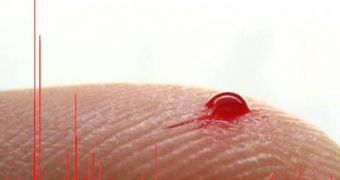Thanks to a new mass spectrometric method devised by scientists at the Max Planck Institute for Chemical Ecology, in Jena, Germany, working together with colleagues from the Czech Academy of Sciences, in Prague, the Czech Republic, doctors could soon require only a single drop of blood – less than a micro liter – to detect metabolites such as sugars, fatty acids, amino acids and other organic substances. The team based its research on the classical mass spectrometry (MALDI-TOF/MS) method, but took it to a whole new level. The new technique has been dubbed Matrix-Assisted Laser Desorption/Ionization (MAILD).
Over the past two decades, mass spectrometry (MALDI) has been the main investigation method for assessing molecular compositions of various substances, as well as the structure of targeted chemical compounds. The most useful applications were found in medicine, but also in small-scale biostudies, such as that of large biomolecules. In larger-scale applications, blood samples are crystallized with the addition of a chemical known as a matrix. When the mix is zapped with a specific type of laser, the substance in the sample creates certain kinds of ions, which can then be detected and accurately identified.
The main disadvantage of MALDI is the fact that the matrix substance also creates low-mass ions, which are also identified by the scanners. In other words, it's not only the sample that creates readable material. “Because of these small interfering ions we were not able to analyze small molecules that play crucial roles in the metabolism of organisms. The ions that originated from conventional matrices were like a haystack in which we wanted to find a few and important needles,” the Head of the Max Planck Institute mass spectrometry/proteomics research group, Ales Svatos, says.
For the new technology, the research team started looking at novel ways of making more metabolites visible to the scanners. So, they focused on reducing the interference from the matrix substance, and managed to do that through the Brønsted–Lowry acid-base theory. Once the hypothesis was applied, the researchers were immediately able to discover up to 100 metabolites in very small samples.
“The analysis of a very small plant leaf sample from Arabidopsis thaliana, in fact a circle area with a radius of just about 0.5 millimeter, revealed over a hundred analyte peaks, among which 46 metabolites could be identified. Interestingly, among them were eight of a total of eleven intermediates of the citric acid cycle, which is vital for most organisms,” International Max Planck Research School PhD student Rohit Shroff, who has been the leader of the experiments, concludes.

 14 DAY TRIAL //
14 DAY TRIAL //